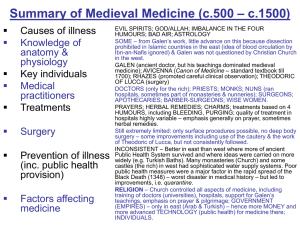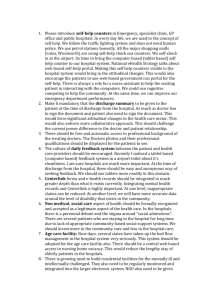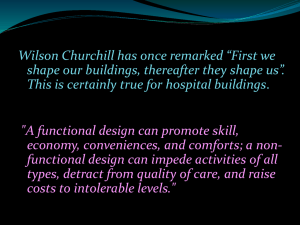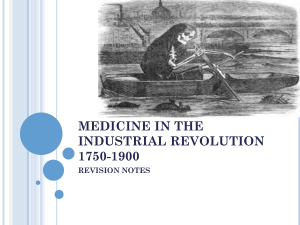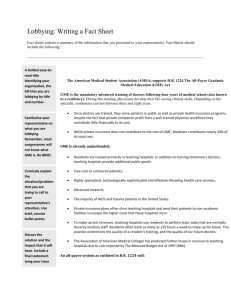Click here to read all insights.
advertisement
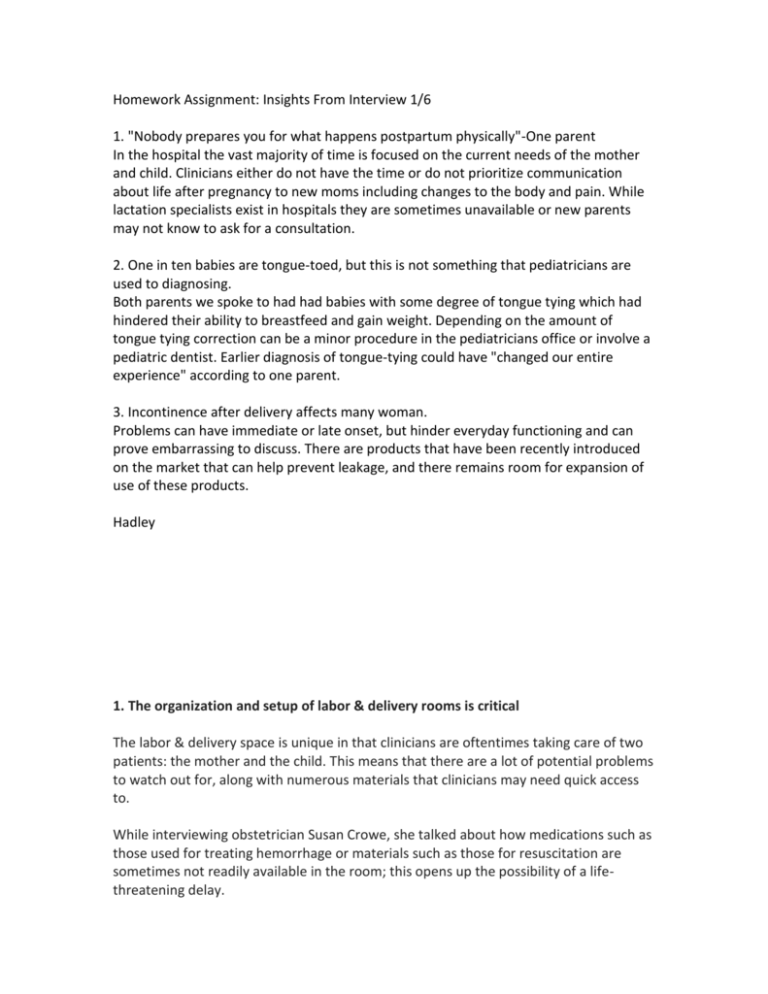
Homework Assignment: Insights From Interview 1/6 1. "Nobody prepares you for what happens postpartum physically"-One parent In the hospital the vast majority of time is focused on the current needs of the mother and child. Clinicians either do not have the time or do not prioritize communication about life after pregnancy to new moms including changes to the body and pain. While lactation specialists exist in hospitals they are sometimes unavailable or new parents may not know to ask for a consultation. 2. One in ten babies are tongue-toed, but this is not something that pediatricians are used to diagnosing. Both parents we spoke to had had babies with some degree of tongue tying which had hindered their ability to breastfeed and gain weight. Depending on the amount of tongue tying correction can be a minor procedure in the pediatricians office or involve a pediatric dentist. Earlier diagnosis of tongue-tying could have "changed our entire experience" according to one parent. 3. Incontinence after delivery affects many woman. Problems can have immediate or late onset, but hinder everyday functioning and can prove embarrassing to discuss. There are products that have been recently introduced on the market that can help prevent leakage, and there remains room for expansion of use of these products. Hadley 1. The organization and setup of labor & delivery rooms is critical The labor & delivery space is unique in that clinicians are oftentimes taking care of two patients: the mother and the child. This means that there are a lot of potential problems to watch out for, along with numerous materials that clinicians may need quick access to. While interviewing obstetrician Susan Crowe, she talked about how medications such as those used for treating hemorrhage or materials such as those for resuscitation are sometimes not readily available in the room; this opens up the possibility of a lifethreatening delay. Additionally, she mentioned that occasionally the needs of both patients are so high that the traditional policy has become to separate them. This is in part because the supplies, resources, and environment necessary for caring for the child may be insufficient in the classic delivery room. For example, after the mother has a C-section, the baby is sometimes brought to another room (named the pediatric intermittent nursery or something similar at Stanford). Unfortunately, this means that the mother is separated from her child, an act which is not preferable for a mother after delivery of her own child, and the father is forced to choose between attending to his partner or child for the approximately 2 hour period. 2. The role of communication within this space of healthcare Many of the people we interviewed discussed the value and gaps in communication in this hospital setting. Neonatologist Henry Lee taught us about the various groups and "teams" that exist for each delivery - for example, there may be two nurses, a pediatrician, and a obstetrician that assist with the delivery, but potentially an anesthesiologist, primary obstetric nurse, and extra nurse in case there is a need for a C-section operation. I was curious about how members of each team were divided or delegated, and Henry mentioned that sometimes communication may be slightly delayed because not everyone knows each other's names in the delivery room. This raises obstacles in communication, as demanding "I need a ____" to a crowded, busy, and hectic room is less effective compared to asking someone directly. On the other hand, the obstetrician retold a past positive experience she had that revolved around easy communication with an anesthesiologist. In this case, working alongside an anesthesiologist who shared similar values during a C-section operation allowed them to detect the onset of sepsis (a life-threatening complication of infection) early on. This is a case in which great communication between two clinicians in this healthcare space created safer conditions. Lastly, we also were able to speak with a parent who had a premature delivery of her child. She had an overall positive experience in communicating with her team of clinicians at Stanford, telling us about the general vibe of "organized chaos" in the labor & delivery room. However, she mentioned that a doctor had disagreed on the standard procedure that the clinical team should undergo for her case, and that it had impaired her experience. This demonstrates an example of when communication may be inappropriate, or how conflicts that are not properly resolved in the clinical team may negatively impact the patient. Additionally, she brushed upon her lack of preparedness for the possibility of a premature delivery and the difficulty of communicating with her physician that something may be wrong during the early signs of early delivery. These were all very valid problems that are related to poor, inappropriate, or lack of communication. 3. The relationship between small and large hospitals Neonatologist Henry Lee also provided some great insights into the relationship between small and large hospitals that were interesting to learn about. For instance, smaller hospitals often refer cases to larger ones, as they may not have the specialized training, resources, or capacity to adequately care for the patient. However, the partnerships between these hospitals are not always as simple as geographical proximity (this is potentially unfortunate for the patient). Instead, small hospitals may refer patients to larger hospitals for financial incentives, or because there has been a long-lasting positive relationship and high level of patient satisfaction. Lastly, large hospitals may sometimes provide educational workshops and training for smaller hospitals. This was particularly interesting to learn about, as I had not known of these dynamics between different hospitals/care facilities before; this new knowledge makes me wonder about the benefits, flaws, and opportunities in this system. Emily 1) (From Ruth Ann) The largest challenge that arose from the clinician standpoint involves the electronic medical records (EMR) system that has been recently instated in practices nationally. Inter-communication is nearly impossible, with staff being unable to copy/paste medical records from other facilities into their own patients’ profiles, adding time and frustration to a usually smooth and efficient process. More importantly, the system is detracting from the patient experience and the patient-faculty relationship because the nurse/clinician spends most of the time with his/her back to the patient, typing into the system (instead of listening intently and scribing in a paper chart). Furthermore privacy also seems to be an issue because the system is easily hack-able. One benefit is that it makes billing easier. Clearly this is an area for modification and development. 2) From Jennifer (mother of 3 kids): The delivery room environment is extremely important. The room for all three of her births felt very sterile. Important components to consider: lighting (dim-able, natural, soft, warm not fluorescent), windows, shades (privacy), warm colored walls, comfortable chairs, adequate space for partner/family to sleep/sit, music, television/entertainment. Comfortable atmosphere is ideal. 3) From Nick & Louise (sp?) parents: Medicalization of birth is a cultural problem and many are uninformed on the process, hard to obtain thorough, accurate information (Nick). Labor beds are not comfortable, also wearing lots of bandages and have bulk mass around rear end, should accommodate for this in bed. Need different chairs, more comfortable. Need a good chair in the shower! (Shower good place to be after birth because of warm, soothing water). Hannah 1. The neonatologist has a role as an emotional regulator, behaving with joy for successful prognoses while also giving patients caution when the baby might be sick. His emotions and behavior are reflected on and heavily influence those of the patient. 2. The OB's best work day was described as one in which the room was set up and her tools were ready to go, and her worst work day was described as one in which the medications were not immediately available and instruments were not available for the pediatrician. Thus, reliability, cooperation, and efficiency in the room and workflow of clinicians are crucial. 3. The physical space in the delivery room is highly sterile and thus scary, according to the mother. The room is also small and has a lot of people, so it felt chaotic to her. She would have wanted to see a more warm, home-like environment. Having more space for privacy and dealing with pain would make the patient more comfortable, and other techniques, such as music and lights, could be used to make the patient feel more relaxed and less scared and embroiled in chaos, which was the root issue of her dissatisfaction with the hospital room. Eesha 1. Familiarity: From the standpoint of doctors, the internal dynamics of a team — whether involved in labor and delivery or post natal recovery — are key to a successful delivery. This means developing teams that work well together and have a sense of familiarity with one another. This can help reduce power struggles, due to burning out from long hours, reduce “awkward” between doctors, and increase teamwork between doctors. From the standpoint of patients, the mothers often expressed a sense of comfort when they were with their own OB/GYN or someone who shares a similar philosophy to their birth plan. Mothers often like for doctors to become a part of the process and take a large role in it. However, as pointed out the due to the routine nature of labor and delivery, many doctors are susceptible to becoming numb to these situations and play a minimalistic role. 2. Constant Communication: In the heat of a moment during any complications with delivery, the doctors, patients, and patients can easily suffer from a loss of communication and coordination. Often times a single doctor is assigned the duty to relay information to the patients, but this simply isn’t feasible with a limited staff and small teams. As explained by a mother, the lack of communication can easily reduce trust in such a delicate relation between doctor and patient. Many doctors described the parents as being a vital part of labor and delivery team. For this reason, doctors must remain “aware of the parents” whenever possible. 3. Condition of Rooms Hospitals are the safest place to give birth to a baby. However, in the process of creating an extremely safe environment, some hospitals have all but neglected the need to also create warm and welcoming rooms for mothers. Many mother describe the white, cold, and practically lifeless rooms to be too “sterile" and “unwelcoming.” At the same time, usually all the mother can see is a plain ceiling, or the people immediately near them. This is because the majority of their view is obstructed by curtains. An effort is required to design more inviting rooms for labor and delivery. Ribhav


